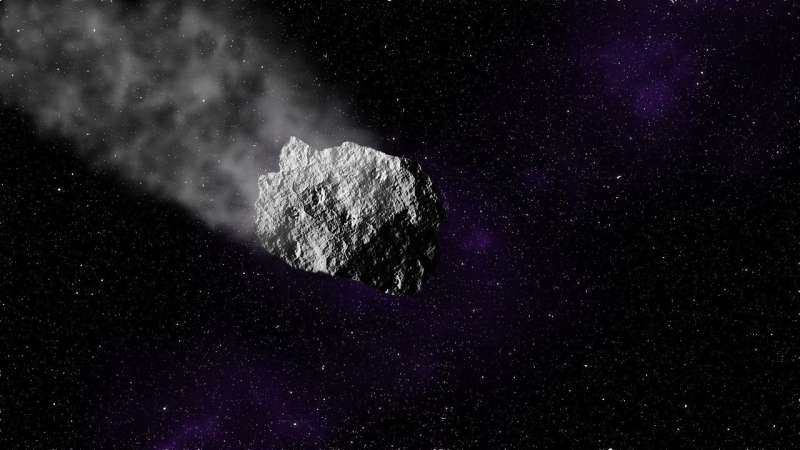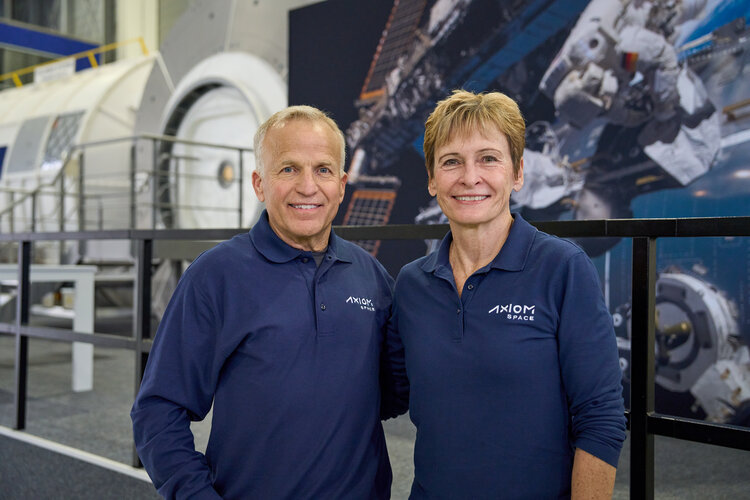NASA's Lucy spacecraft adjusts course for asteroid flyby in November
Friday, 19 May 2023 14:19
On May 9, NASA's Lucy spacecraft carried out a trajectory correction maneuver to set the spacecraft on course for its close encounter with the small main belt asteroid Dinkinesh. The maneuver changed the velocity of the spacecraft by only about 7.7 mph (3.4 m/s).
Even though the spacecraft is currently traveling at approximately 43,000 mph (19.4 km/s), this small nudge is enough to move the spacecraft nearly 40,000 miles (65,000 km) closer to the asteroid during the planned encounter on Nov. 1, 2023. The spacecraft will fly a mere 265 miles (425 km) from the small, half-mile-(sub-km)-sized asteroid, while traveling at a relative speed of 10,000 mph (4.5 km/s).
The Lucy team will continue to monitor the spacecraft's trajectory and will have further opportunities to fine tune the flight path if needed.
The Lucy team is also continuing to analyze the data collected from its spring instrument calibration campaign and make other preparations for the mission's first asteroid encounter. This encounter will provide a valuable test of the spacecraft's systems and procedures to make sure that everything operates as expected during the mission's high-speed asteroid encounters.
Inmarsat orders 3 smallsats to bolster L-band safety services
Friday, 19 May 2023 11:00
Inmarsat has ordered three small geostationary satellites from 3D printing specialist Swissto12 for a launch in 2026 to fortify its L-band safety services.
Space Force looks at options for relieving Cape Canaveral launch congestion
Friday, 19 May 2023 10:14
With increasing activity pushing Florida’s launch sites to their limits, the Space Force is studying ways to move some of that activity elsewhere, including to California.
Axiom astronauts to train at the European Astronaut Centre
Friday, 19 May 2023 08:11
Facilities at ESA's European Astronaut Centre are buzzing with training activities. While a new generation of ESA astronauts began their basic training last month, private astronauts Peggy Whitson and John Shoffner, part of Axiom Space's Crew-2, visited the European Astronaut Centre (EAC) near Cologne, Germany, in February to receive training by ESA instructors for their upcoming journey to the International Space Station.
The Axiom-2 crew is currently scheduled to launch no earlier than 21 May 2023.
New sensors with the HOTS for extreme missions
Friday, 19 May 2023 07:30 Modern technologies are laden with sensors - a now-customary fact of life in much of the world. On smart watches and phones, and in cars and homes, sensors help monitor health, adjust various settings for comfort, and warn of potential dangers. More widely, sensors are deployed across countless commercial and defense systems, including in the oil and gas sector, the automotive industry, alternat
Modern technologies are laden with sensors - a now-customary fact of life in much of the world. On smart watches and phones, and in cars and homes, sensors help monitor health, adjust various settings for comfort, and warn of potential dangers. More widely, sensors are deployed across countless commercial and defense systems, including in the oil and gas sector, the automotive industry, alternat Momentus deploys Qosmosys satellite and on-orbit support of Caltech hosted payload
Friday, 19 May 2023 07:30 Momentus Inc. (NASDAQ: MNTS) has deployed the Qosmosys Zeus-1 payload from its Vigoride-5 Orbital Service Vehicle and is now providing comprehensive hosted payload support services for Caltech's Space-based Solar Power Project payload.
The Qosmosys Zeus-1 payload was deployed in orbit on May 10, 2023. Effective May 15, 2023, Momentus is providing on-orbit support to Caltech, including prov
Momentus Inc. (NASDAQ: MNTS) has deployed the Qosmosys Zeus-1 payload from its Vigoride-5 Orbital Service Vehicle and is now providing comprehensive hosted payload support services for Caltech's Space-based Solar Power Project payload.
The Qosmosys Zeus-1 payload was deployed in orbit on May 10, 2023. Effective May 15, 2023, Momentus is providing on-orbit support to Caltech, including prov China's next space exploration to feature new faces
Friday, 19 May 2023 07:30 China's next manned mission, the Shenzhou XVI, is scheduled to be launched within this month to transport three astronauts to the Tiangong space station, according to plans made by the China Manned Space Agency.
It will become the first crewed mission to the Tiangong station after its completion, which was done through the Shenzhou XIV and XV flights.
The Shenzhou XVI crew members, w
China's next manned mission, the Shenzhou XVI, is scheduled to be launched within this month to transport three astronauts to the Tiangong space station, according to plans made by the China Manned Space Agency.
It will become the first crewed mission to the Tiangong station after its completion, which was done through the Shenzhou XIV and XV flights.
The Shenzhou XVI crew members, w Solar-powered balloons detect mysterious sounds in the stratosphere
Friday, 19 May 2023 07:30 Imagine if sending your science experiment 70,000 ft in the air just took painter's plastic, tape, a dash of charcoal dust, and plenty of sunlight.
Daniel Bowman of Sandia National Laboratories will present his findings using solar-powered hot air balloons to eavesdrop on stratospheric sounds at the upcoming 184th Meeting of the Acoustical Society of America, running May 8-12 at the Chicag
Imagine if sending your science experiment 70,000 ft in the air just took painter's plastic, tape, a dash of charcoal dust, and plenty of sunlight.
Daniel Bowman of Sandia National Laboratories will present his findings using solar-powered hot air balloons to eavesdrop on stratospheric sounds at the upcoming 184th Meeting of the Acoustical Society of America, running May 8-12 at the Chicag China unveils first 3D rainfall maps from inaugural Fengyun-3G Satellite
Friday, 19 May 2023 07:30 On May 15, the China Meteorological Administration unveiled the first set of maps from the country's premier low-inclination orbit precipitation measurement satellite, Fengyun-3 G (FY-3G). These images, supplied by the National Satellite Meteorological Center, illustrate the three-dimensional structure of precipitation at different levels. This invaluable data, collected from the six payloads ab
On May 15, the China Meteorological Administration unveiled the first set of maps from the country's premier low-inclination orbit precipitation measurement satellite, Fengyun-3 G (FY-3G). These images, supplied by the National Satellite Meteorological Center, illustrate the three-dimensional structure of precipitation at different levels. This invaluable data, collected from the six payloads ab Earth from Space: Oslo, Norway
Friday, 19 May 2023 07:00 Image:
The Copernicus Sentinel-2 mission takes us over Oslo, Norway’s capital and largest city, and host of the 2023 Global Space Conference on Climate Change, taking place on 23–25 May.
Image:
The Copernicus Sentinel-2 mission takes us over Oslo, Norway’s capital and largest city, and host of the 2023 Global Space Conference on Climate Change, taking place on 23–25 May. SpaceX Falcon 9 rocket deploys 22 second-generation Starlink satellites
Friday, 19 May 2023 06:50 The first of two SpaceX missions planned to launch in less than seven hours took off early on Friday from Cape Canaveral, carrying 22 upgraded, new-generation Starlink broadband satellites.
Weather conditions delayed the original launch time from 12:41 a.m. EDT (0421 UTC) to 2:19 a.m. EDT (0619 UTC). The Starlink mission launched from Space Launch Complex 40 (SLC-40) at the Cape Canaveral
The first of two SpaceX missions planned to launch in less than seven hours took off early on Friday from Cape Canaveral, carrying 22 upgraded, new-generation Starlink broadband satellites.
Weather conditions delayed the original launch time from 12:41 a.m. EDT (0421 UTC) to 2:19 a.m. EDT (0619 UTC). The Starlink mission launched from Space Launch Complex 40 (SLC-40) at the Cape Canaveral NASA begins feedback process for Moon to Mars Architecture
Friday, 19 May 2023 06:50 As NASA builds a blueprint for human exploration throughout the solar system for the benefit of humanity, efforts to advance the agency's Moon to Mars architecture concept development approach are underway. NASA will host a virtual webinar at 2 p.m. EDT, Monday, May 22, in which leaders from the agency's Exploration Systems Development Mission Directorate will discuss how U.S. commercial industr
As NASA builds a blueprint for human exploration throughout the solar system for the benefit of humanity, efforts to advance the agency's Moon to Mars architecture concept development approach are underway. NASA will host a virtual webinar at 2 p.m. EDT, Monday, May 22, in which leaders from the agency's Exploration Systems Development Mission Directorate will discuss how U.S. commercial industr After 2 delays, SpaceX hopes next launch attempt will send satellites toward orbit
Friday, 19 May 2023 06:50 SpaceX hopes to launch 22 satellites for a Starlink mission early Friday morning after previously suffering two delays.
The Falcon 9 rocket carrying the second-generation Starlink V2 Mini Internet satellites are scheduled to launch at 12:41 a.m. EDT from the Cape Canaveral Space Force Station in Florida, the company said in a news release.
If all goes well, the first stage booste
SpaceX hopes to launch 22 satellites for a Starlink mission early Friday morning after previously suffering two delays.
The Falcon 9 rocket carrying the second-generation Starlink V2 Mini Internet satellites are scheduled to launch at 12:41 a.m. EDT from the Cape Canaveral Space Force Station in Florida, the company said in a news release.
If all goes well, the first stage booste Astronomers want your help hunting for asteroids
Friday, 19 May 2023 06:50 Anyone can become an asteroid hunter thanks to a new program launched by astronomers at the University of Arizona Lunar and Planetary Laboratory. As part of the NASA-funded Catalina Sky Survey, the scientists created an online portal that opens their mission - the discovery and identification of space rocks that regularly visit Earth's neighborhood - to the general public.
While gazing up
Anyone can become an asteroid hunter thanks to a new program launched by astronomers at the University of Arizona Lunar and Planetary Laboratory. As part of the NASA-funded Catalina Sky Survey, the scientists created an online portal that opens their mission - the discovery and identification of space rocks that regularly visit Earth's neighborhood - to the general public.
While gazing up Remotely waiting in Gale: Sols 3832-3833
Friday, 19 May 2023 06:50 Earth planning date: Wednesday, May 17, 2023. As I'm writing this, it's about 8:30 pm on sol 3831 in Gale crater: ~16 hours after our SAM instrument ran its EGA experiment (which Abigail described so clearly in yesterday's blog!).
While we were able to confirm the success of the Ubajara drill sample drop-off to SAM and the start of the EGA, our first communication with Earth after the EGA
Earth planning date: Wednesday, May 17, 2023. As I'm writing this, it's about 8:30 pm on sol 3831 in Gale crater: ~16 hours after our SAM instrument ran its EGA experiment (which Abigail described so clearly in yesterday's blog!).
While we were able to confirm the success of the Ubajara drill sample drop-off to SAM and the start of the EGA, our first communication with Earth after the EGA 
